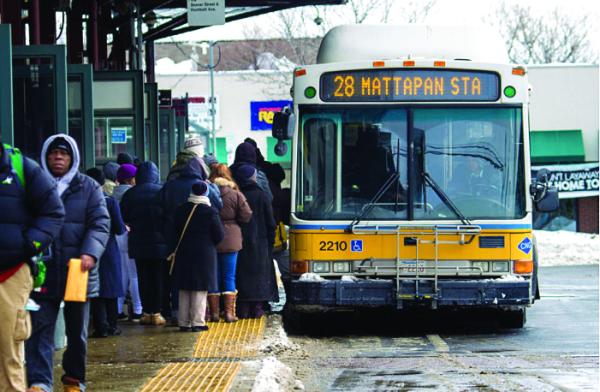May 5, 2022

Commuters board an MBTA bus bound for Mattapan Square. Jesse Costa/WBUR photo
MBTA overseers have stamped their approval on a $2.55 billion fiscal 2023 budget draft that adds nearly 150 new positions to address safety needs, avoids fare hikes and service cuts, and drives up agency spending by 8 percent at a time when T revenues face a precarious future
As they prepare once again to dip into a fast-dwindling pot of emergency federal aid, and while they simultaneously give the green light to expanding bus service and ramping up spending on maintenance projects, the transit agency’s board voiced growing concerns about a looming financial crisis that could imperil efforts to expand fare-free services, a goal of many elected officials and transportation advocates.
With a budget deficit of several hundred millions of dollars forecast for fiscal 2024, the MBTA Board of Directors should welcome “every suggestion on how we might raise additional revenues from any source imaginable in order to help deal with this problem,” board chair Betsy Taylor said last Thursday when the draft budget was approved by a 6-0 vote.
“People should not look to prospective cuts to safety or maintenance in order to balance the budget should there be a deficit by this time next spring,” Taylor said before voting in favor of the draft. “I’m hoping that some of it will be offset by returning ridership, but should there be such a deficit, we will have to look elsewhere from safety or basic maintenance in order to balance that budget. I fear that might leave services as one of the few remaining items.”
The budget calls for a $199 million increase in spending or 8 percent more than in fiscal 2022. The MBTA Advisory Board, an independent group that represents cities and towns whose tax dollars help fund the system, will now review the proposal before T overseers take up a final proposal later this spring.
New spending in the proposal includes a total of 330 new employee positions, about 5 percent more than in the fiscal 2022 budget. Of those, 148 would focus specifically on safety needs such as equipment and station inspections, rail yard safety, testing new Red and Orange Line cars, and signal maintenance.
The budget also calls for $5.5 million in new spending on a Quality Management System Program to address elevator and escalator quality assurance, inspecting stairs across the system, examining rail track and more.
Officials have been working to staff up safety-related positions at the T after an independent panel in 2019 concluded that financial cutbacks, lapses in maintenance, and leadership issues created a “questionable” approach to safety.
MBTA Chief Financial Officer Mary Ann O’Hara said the suggested spending plan does not raise fares on riders nor trim any planned bus, train, ferry or paratransit service, even though projected revenues again fall short of spending.
Instead, the T will use $316 million in one-time federal funding to close the gap. Officials previously said that transfer amount would leave just $100 million of the nearly $2 billion in Covid relief money remaining for fiscal year 2024, which will likely be insufficient to produce a balanced budget.
“Beginning in fiscal year ‘24 and continuing thereafter, without additional, sustainable, recurring revenue, the MBTA will face a series of challenging decisions to maintain service levels and the enhanced staffing reflected in this proposal and in recent budgets,” O’Hara told the board. “One-time revenues and one-time fixes will not durably balance the MBTA’s budget.”
While the MBTA has long struggled with a structural gap between available revenues and spending goals, the pandemic has exacerbated its financial struggles.
More than two years after the virus first upended public life, the rebound in ridership has only clawed back a part of the fare revenue the T once counted on to form roughly one-third of its budget. And because fewer people are driving to stations or seeing posters along platforms, revenue from parking and advertising shrunk 62 percent and 44 percent, respectively, from FY19 to FY21, according to O’Hara.
MBTA General Manager Steve Poftak said that ridership is hovering around 50 percent of pre-COVID levels on the subway, 70 percent on buses, and 55 percent on the commuter rail.
If the current rate of return continues, the T will likely face a budget gap of $236 million in FY24, according to the agency projections; that swells to $421 million when applying a more pessimistic projection to ridership trends.
“It’s very sobering to look at the future beyond next year,” MBTA board member Mary Beth Mello said during last Thursday’s meeting. “It would be my preference, should revenues be higher than expected, that we start preserving those in the operating category for future years.”
While Taylor, the new board’s chair, said she wants her colleagues to consider revenue from “any source imaginable,” the MBTA historically has been hesitant to ask Beacon Hill to rethink how the state funds the transit agency.
The House in March 2020 approved tax and fee hikes that Democratic leaders said would generate more than half a billion dollars per year for transportation needs, but the bill slipped into the void when Covid hit. In the two years since then, legislative leaders have demonstrated virtually no interest in debating new transportation revenues, although a constitutional amendment on this year’s ballot, if approved, could tap a new source of transportation funds by adding a surtax on household income above $1 million per year.
Despite the dismal financial outlook, T officials continue to forge ahead with major spending initiatives.
Poftak announced the agency will reveal its Bus Network Redesign map next month, saying it would boost bus service 25 percent across the board. A T spokesperson could not provide a cost estimate for that project, but the fiscal 2023 budget would fund about 15 percent of the total, according to O’Hara’s presentation.
The T also plans to transfer $500 million in currently available funding away from the operating side -- which forecasts to have a gap of hundreds of millions of dollars next year -- and spend it immediately on a string of projects including electric bus infrastructure, safety improvements, and workforce retention.
When he outlined the plan in January, Poftak said his team felt it important to use available one-time funds to target behind-the-scenes improvements at an agency where budget shortfalls are a familiar affair.
“If you’re out on the system, visually, you know there’s a number of additional investments that we need to make,” Poftak said at a Jan. 27 board meeting. “We also know that we are facing a shortage of capital funds that is particularly acute in the middle of the upcoming decade. This $500 million allows us to at least begin addressing some of that shortfall, and it allows us to make some important investments across safety, in our workforce, and on some important projects, particularly in bus.”
Asked by board members last Thursday how the agency would balance additional projects in the pipeline with the impending “fiscal cliff,” Poftak said that “there is a bit of a feedback loop between what is the cause and what is the effect.”
“We will be challenged to incorporate large costly initiatives absent some additional source of revenue, and I think that’s been part of the discussion around means-tested fares,” he said.



